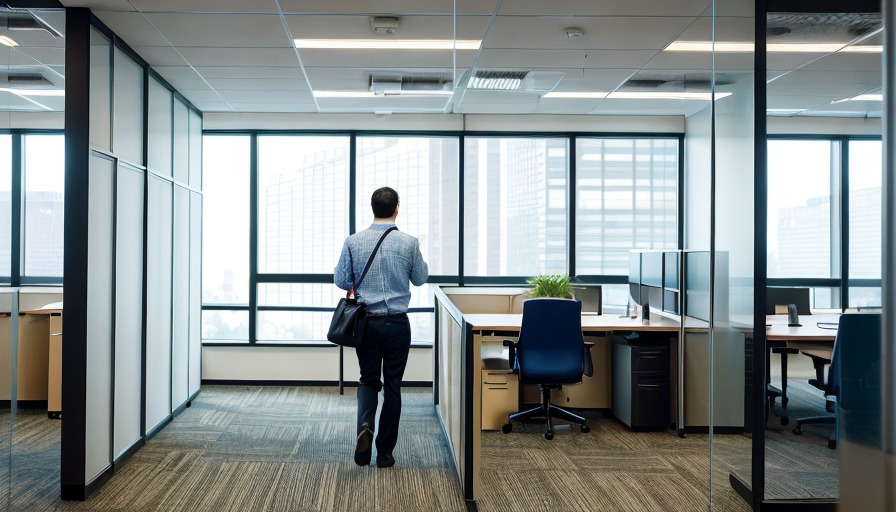

As 2024 unfolds, a surge of uncertainties accompanies the workforce into the new year. Hybrid work, once lauded for its promise of flexibility and balance, now stands at the crossroads of a growing concern: the insidious rise of hybrid work anxiety. Recent studies, notably McKinsey’s report, spotlight the escalating challenges; with 87% of structured hybrid companies mandating an average of 2.54 office days per week, the pressures of juggling diverse work modes amplify the strain on individuals.
The persistent struggle to navigate this duality has taken a toll on the workforce’s mental health. This anxiety, often linked to depression, has led to an estimated annual loss of $1 trillion in global productivity. The forecasted impact of depression and anxiety on productivity is estimated to reach a staggering $16 trillion by 2030, underscoring the pressing need for proactive measures.
To navigate and overcome office anxiety, let’s delve into the common challenges faced and explore the prominent solutions we offer.
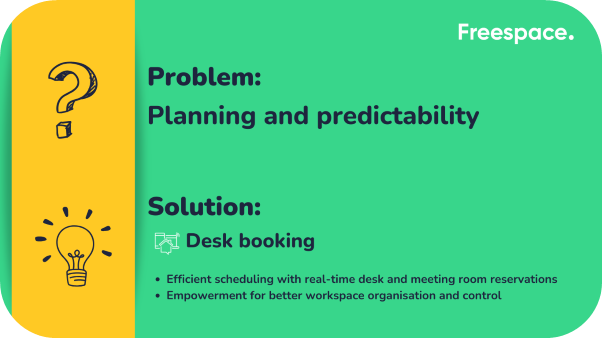
1. Problem: Planning and unpredictability
In the hybrid work environment, situational anxiety (anxiety triggered by new or stressful situations) manifests in various forms. The most prevalent being uncertainty about space availability, lack of familiarity with new desk settings, and inability to anticipate others’ office attendance plans. For employees navigating multiple office locations, the complexity of travelling between sites exacerbates these concerns forming between in-person and remote teammates.
Solution: Desk booking
An Employee App empowers employees to manage hybrid work anxiety by allowing them to choose preferred desk types (near windows or aisles), set restricted preferences, and select desirable amenities (entry/exit points, dual monitors, and sit-stand desks). The app ensures seamless navigation of floor plan locations for new joiners, fostering comfort, productivity, and collaboration.
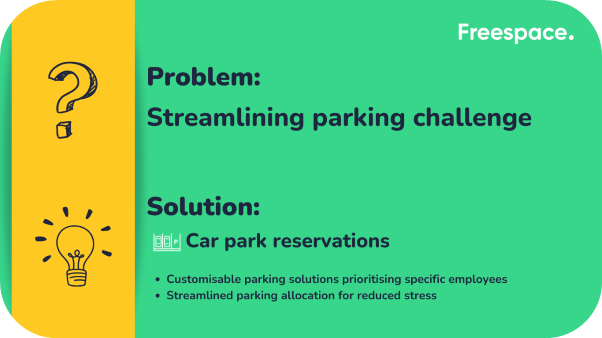
2. Problem: Streamlining parking challenges
One significant challenge presented by hybrid work arrangements relates to the allocation of office space and its subsequent impact on parking availability. Often, organisations prioritise optimal desk-sharing ratios, sometimes overlooking or reducing parking facilities. This can result in a disproportionate reduction in the number of available parking spots. Moreover, managing diverse scheduling needs and accommodating restricted users like Electric Vehicle (EV) or Disabled parking further complicates this issue.
Solution: Car park reservations
Technology adoption like that of an Employee App mirrors the desk allocation process, allowing users to request a parking space for either a full day or part-day, ensuring optimal usage. The system enables the registration of car plates for effective security tracking. Users can indicate preferences for electric vehicle (EV) charging, specifying whether it’s enabled or disabled. Additionally, the solution accommodates considerations for handicap parking, providing a seamless and user-friendly experience for booking parking spaces.
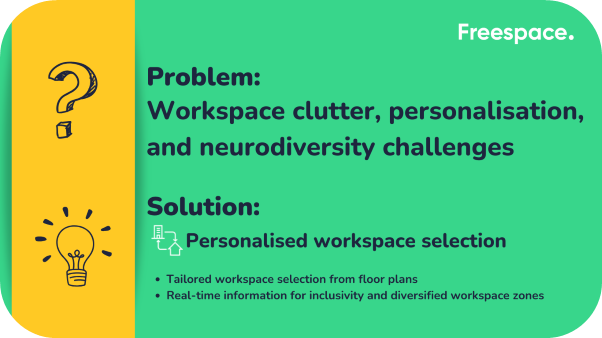
3. Problem: Workspace clutter, personalisation, and neurodiversity challenges
Unassigned workspaces and desk sharing can cause anxiety, leading to challenges like feeling overwhelmed, difficulty concentrating, social avoidance, and communication barriers. Neurodiverse employees, with varying workspace preferences, require an inclusive environment to overcome these obstacles.
Solution: Personalised workspace selection
Creating diverse workspace areas with plants, calming colours, and comfortable furniture, along with essentials like headphones, caters to the comfort and preferences of neurodiverse individuals, including those with colour blindness. Real-time updates on available spaces offer opportunities for change and relaxation. Through the Freespace Employee App, individuals can choose their workspace from a floor plan or request specific features, ensuring a personalised and organised setup. The App is accessible and accommodates various needs. And Digital Signage aids for better navigation. This inclusive approach supports employees in finding comfortable and productive environments.
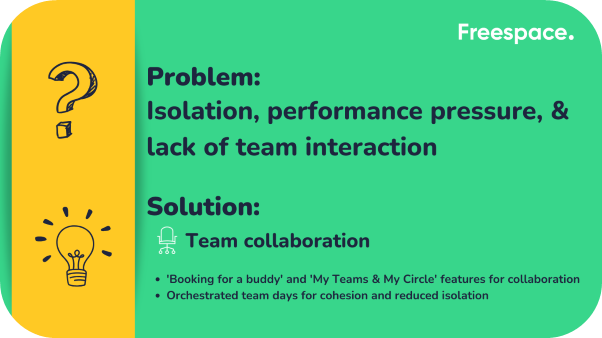
4. Problem: Isolation, performance pressure, and lack of team interaction
The absence of face-to-face interactions and physical distance from colleagues can breed feelings of isolation (70% of hybrid workers report feeling lonely), impacting individuals’ sense of belonging and connection within the organisation. Additionally, the pressure to showcase productivity and value in a hybrid setup may induce stress and anxiety. Concerns about meeting expectations, job security, and the perceived effectiveness of remote work contribute to this apprehension, with employees fearing their contributions might go unnoticed.
Solution: Team collaboration
In response to the prevalent challenges like isolation and lack of team interaction, facilitating greater team connectivity and collaboration emerges as a pivotal solution. Implementing strategies that encourage office visits with colleagues and securing adjacent workspaces (by booking for a buddy – a feature also designed to help new employees onboard smoothly), as well as enhancing visibility into team members’ locations (using ‘My Teams’ and ‘My Circle’ features), fosters a sense of proximity and teamwork when it comes to tackling anxiety. Dedicated team days orchestrated using an Employee App creates opportunities for employees to showcase their contributions, minimising isolation, alleviating performance pressure, and enhancing collaboration, ultimately fostering a more inclusive and supportive hybrid work environment.
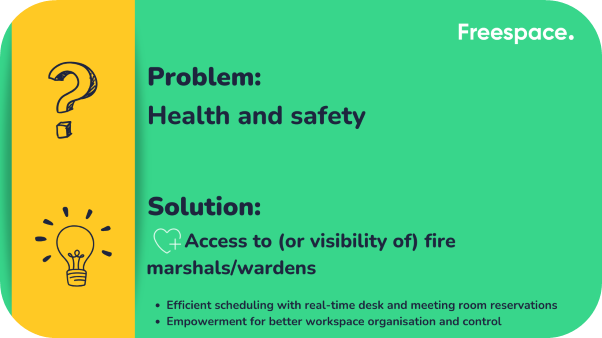
5. Problem: Health and safety
Health concerns have always been a hot topic at the workplace since the pandemic. And especially, when it comes to crowded and unsafe working environments, compliance with the Regulatory Reform (Fire Safety) Order 2005 (UK) necessitates the presence of fire wardens in workplaces. This order mandates that a designated ‘responsible person’ oversees all fire safety measures within businesses.
Solution: Access to (or visibility of) fire marshals/wardens
Ensuring employee safety is crucial, particularly for those managing workplace anxiety. Swift access to First Aid providers via the app offers which includes features to locate fire marshals and connect with live doctors, offers immediate assistance during emergencies, fostering a sense of security. Real-time air quality monitoring using Freespace PAM reassures employees about a safe working environment and ensures optimal working conditions. Utilising innovative technology like Freespace Analytics, Signage, Sensors and Indicators allows safety officers to identify unoccupied spaces efficiently, aiding timely evacuation or assistance during emergencies. This integration of technology not only addresses safety concerns in real-time but also enhances overall safety protocols for businesses.
Hybrid Work Anxiety: Taking Proactive Measures
As we navigate the potential repercussions of unaddressed mental health challenges in the hybrid work landscape, it’s clear that taking proactive measures is crucial to minimise these projected losses. This article provides strategies to reduce hybrid work anxiety, promote inclusivity, and prioritise mental health. By implementing these measures, organisations can mitigate productivity and well-being issues, creating healthier and more effective work environments.
Engaging with Freespace not only aligns with these proactive measures but also presents innovative solutions to foster a sustainable workplace culture. Our commitment to empowering employees and enhancing workplace experiences through technology ensures a seamless implementation of these strategies, nurturing environments where employees can thrive. This transformation turns projected losses into opportunities for growth and productivity. Connect with us to make space for more productivity, well-being, and success with Freespace.


